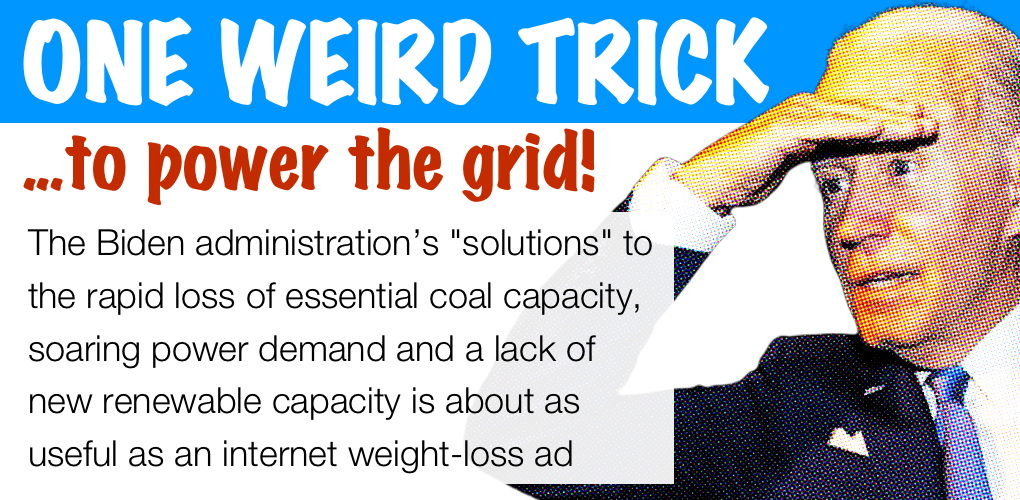
The Biden-EPA’s Alternate Reality
While the U.S. Environmental Protection Agency (EPA) continues to brush aside deep alarm over the grid reliability impacts of its new blitz of power plant rules, evidence is rapidly mounting that the nation’s supply of electricity is already in deep, deep trouble.
In the Midcontinent Independent System Operator (MISO) market, which covers much of the Midwest, reserve margins – an electricity market metric used to determine how much wiggle room operators have during peak demand before it’s lights-out – are rapidly deteriorating with accumulating coal plant losses. The result: prices are suddenly soaring.
In a recent capacity auction, surplus summertime capacity in MISO fell 29% from last year and a full 40% in MISO’s northern and central regions. In response, capacity prices for the upcoming summer and spring seasons roughly tripled. In MISO’s zone 5 — served by Ameren Missouri and Columbia — capacity prices jumped 5,000%, a deafening alarm for expected power supply shortfalls.
Across the country, the rapid loss of essential coal capacity is colliding with soaring power demand and an inability to bring new transmission and renewable capacity to market.
The Biden EPA and Department of Energy claim they have a handle on the problem, but their purported solutions feel like social media influencer hacks to lose 10 pounds of belly fat overnight while still keeping donuts the staple of your diet.
Perhaps reconductoring transmission lines, for example, a new favorite DOE talking point, is some magical silver bullet to solve the glacial pace of interstate transmission additions, but counting on optimistic lab modelling while ignoring on-the-ground reality is almost certainly a recipe for disaster. And make no mistake, that on-the-ground reality is grim.
Doom Loop
Consider the plight of the Cardinal-Hickory transmission line that would serve customers in Minnesota, Iowa and Wisconsin. If approved and built, the power line would connect 161 renewable energy projects to the grid. But for the second time in five years, a federal judge has issued an injunction blocking approval of the project. Like so many interstate transmission lines, the project is stuck and with it the new generating capacity grid operators are counting on to fill rapidly widening gaps in power supply.
As two policy and legal experts recently observed, the Cardinal-Hickory transmission line’s legal problems are indicative of an endless cycle of agency review and litigation holding up new energy projects. They wrote, “This ‘litigation doom loop’ not only halts projects in court, but also makes it difficult to convince investors to hazard the trillions of dollars necessary to build new infrastructure for a clean energy economy.”
As the PJM, the operator of the nation’s largest grid, explained in a timely, new blog, there’s no single issue or quick fix for the challenges facing the addition of new resources. For all the pressure grid operators and the Federal Energy Regulatory Commission have faced in fixing interconnection queues once identified as the key chokepoint to bringing renewables online, the interconnection challenge is now largely moot. It’s everything else now standing in the way.
PJM’s Vice President of Planning, Paul McGlynn, wrote, “according to Lawrence Berkeley National Laboratories, more than 300,000 MW of projects have been approved nationally but have not proceeded to construction – nearly 25% of current generating capacity in the country. Right now, PJM has cleared nearly 40,000 MW of generation projects through our interconnection process that are not moving to construction. Nothing from PJM is holding these projects back, yet they sit idle in PJM and elsewhere due to continued challenges with supply chain, financing and local siting issues.”
This is the alarming reality no silver bullet can fix. The challenges are enormous, diverse and bitingly stubborn. This is not to say these things can’t happen. Progress will be made. But tearing down essential generating capacity before it can possibly be replaced, much less soaring new demand can be met, makes no sense. The nation’s grid reliability crisis is very quickly becoming the Biden EPA-designed grid catastrophe.
- On May 1, 2024
